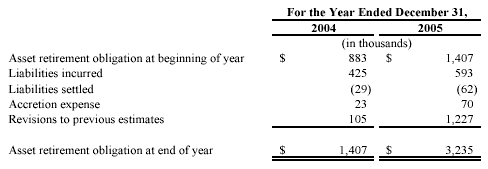| | The following
table is a reconciliation of the asset retirement obligation liability for 2004
and 2005: 
Recently
Issued Accounting Pronouncements On December 16,
2004, the FASB issued SFAS No. 123 (revised 2004), “Share-Based Payment” (“SFAS
No. 123(R)”). SFAS No. 123(R) will require companies to measure all employee stock-based
compensation awards using a fair value method and record such expense in their
consolidated financial statements. In addition, the adoption of SFAS No. 123(R)
requires additional accounting and disclosure related to the income tax and cash
flow effects resulting from share-based payment arrangements. SFAS No. 123(R)
was effective beginning as of the first interim or annual reporting period beginning
after June 15, 2005. On April 14, 2005, the SEC adopted a new rule that defers
the effective date of SFAS No. 123(R) and allows companies to implement the provisions
of SFAS No. 123(R) at the beginning of their next fiscal year. The Company adopted
the provisions of SFAS No. 123(R) during the first quarter of 2006 using the modified
prospective method for transition. The Company believes it is likely that the
impact of the requirements of SFAS No. 123(R) will significantly impact the Company’s
future results of operations and continues to evaluate it to determine the degree
of significance. In May 2005, the FASB issued SFAS No.
154, Accounting Changes and Error Corrections, a replacement of Accounting Principals
Board (APB) Opinion No. 20 and FASB Statement No. 3. This statement changes the
requirements for the accounting and for reporting of a change in accounting principal.
It also applies to changes required by an accounting pronouncement in the unusual
instance that the pronouncement does not include specific transition provisions.
This statement shall be effective for accounting changes and corrections of errors
made in fiscal years beginning after December 15, 2005. The adoption of SFAS No.
154 was implemented for our restatement of financial statements for the year ended
December 31, 2004 and the first three quarters in 2005 due to the change in accounting
for our derivatives. In May 2003, the FASB issued SFAS
No. 150, Accounting for Certain Financial Instruments with Characteristics of
both Liabilities and Equity. The statement requires that an issuer classify a
financial instrument that is within its scope as a liability (or an asset in some
circumstances). A majority of those instruments were previously classified as
equity. Some of the provisions of this statement are consistent with the current
definition of liabilities in FASB Concepts Statement No. 6, Elements of Financial
Statements. The remaining provisions of this statement are consistent with the
Board’s proposal to revise that definition to encompass certain obligations that
a reporting entity can or must settle by issuing its own equity shares, depending
on the nature of the relationship established between the holder and the issuer.
This statement is effective for financial instruments entered into or modified
after May 31, 2003. The company has adopted the provisions of SFAS No. 150. 3.
FINANCIAL RESTATEMENT In connection with the preparation
of our consolidated financial statements for the year ended December 31, 2005,
we reviewed our accounting policy used to account for our derivatives on interest
rate swaps on the Second Lien Credit Facility and for oil and natural gas prices
on our proved producing properties (“Derivatives”) and determined that these the
derivatives entered into in 2004 and 2005 had not been timely designated and lacked
sufficient documentation to be accounted for as cash flow hedges and should have
been accounted for as non-designated derivatives instead of cash flow hedges in
accordance with Statement of Financial Accounting Standards (“SFAS”) No. 133,
“Accounting for Derivative Instruments and Hedging Activities.” Accordingly, as
a result of the changes in accounting for our derivatives for interest rate swaps
and the oil and natural gas hedges we have restated our consolidated financial
statements for the year ended December 31, 2004, as presented in this Form 10-K/A.
All such derivatives in this restatement, including oil and gas derivatives and
interest rate swaps, are now classified as non-designated derivatives and are
marked-to-market, with realized and unrealized gains and losses being reflected
as “markto- market gains (losses) on derivatives, net” within the other income
and expense section of the Statement of Operations. In addition to the financial
statements for the year ended December 31, 2004, these changes in accounting affect
the four quarterly periods of 2004 and the three quarterly periods ended September
30, 2005. These restatements are also presented in the table below. | |